Related Research Articles

Reinhold Andreas Messner is an Italian climber, explorer, and author from the German-speaking province of South Tyrol. He made the first solo ascent of Mount Everest and, along with Peter Habeler, the first ascent of Everest without supplemental oxygen. He was the first person to climb all 14 eight-thousanders, doing so without supplementary oxygen. Messner was the first to cross Antarctica and Greenland with neither snowmobiles nor dog sleds and also crossed the Gobi Desert alone. He is widely considered to be the greatest mountaineer of all time.

The eight-thousanders are the 14 mountains recognized by the International Mountaineering and Climbing Federation (UIAA) as being more than 8,000 metres (26,247 ft) in height above sea level, and sufficiently independent of neighbouring peaks. There is no precise definition of the criteria used to assess independence, and at times, the UIAA has considered whether the list should be expanded to 20 mountain peaks by including the major satellite peaks of eight-thousanders. All of the eight-thousanders are located in the Himalayan and Karakoram mountain ranges in Asia, and their summits lie in the altitude range known as the death zone.
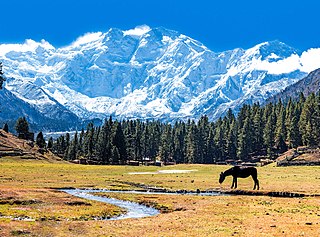
Nanga Parbat, known locally as Diamer, is the ninth-highest mountain on Earth and its summit is at 8,126 m (26,660 ft) above sea level. Lying immediately southeast of the northernmost bend of the Indus River in the Gilgit-Baltistan region of Pakistan-administered Kashmir, Nanga Parbat is the westernmost major peak of the Himalayas, and thus in the traditional view of the Himalayas as bounded by the Indus and Yarlung Tsangpo/Brahmaputra rivers, it is the western anchor of the entire mountain range.

Alan Hinkes OBE is an English Himalayan high-altitude mountaineer from Northallerton in North Yorkshire. He is the first British mountaineer to claim all 14 Himalayan eight-thousanders, a feat he completed on 30 May 2005.

Juan Eusebio Oiarzabal Urteaga, commonly known as Juanito Oiarzabal, is a noted Spanish Basque mountaineer. He has written four books on the subject. He was the 6th man to reach all 14 eight-thousander summits, and the third to do so without supplemental oxygen. He was the first person to climb the top three summits twice and the oldest climber to summit Kangchenjunga, at almost 53, until Carlos Fontan did so in 2014, at 75 years old. In 2004, he lost all his toes to frostbite after summiting K2.
Vladyslav "Slava" Oleksandrovych Terzyul, was a Ukrainian alpinist.

Artur Henryk "Słon” Hajzer was a Polish mountaineer. Hajzer summitted seven eight-thousanders, several via new routes and made the first winter climb of Annapurna on February 3, 1987.
Andrew James Lock OAM is an Australian mountaineer. He became the first, and still remains the only, Australian to climb all 14 "eight-thousanders" on 2 October 2009, and is the 18th person to ever complete this feat. He climbed 13 of the 14 without bottled oxygen, only using it on Mount Everest, which he has summited three times. He retired from eight-thousander climbing in 2012.

Anna Czerwińska was a Polish climber. She is known for being the then-oldest woman to summit Mount Everest, doing so at the age of 50. She also published several books about mountaineering.
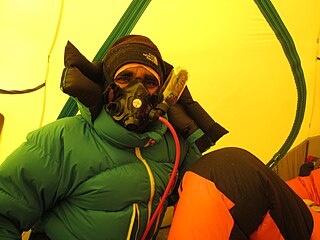
Expedition climbing, is a type of mountaineering that uses a series of well-stocked camps on the mountain leading to the summit, that are supplied by teams of mountain porters. In addition, expedition climbing can also employ multiple 'climbing teams' to work on the climbing route—not all of whom are expected to make the summit—and allows the use of supports such as fixed ropes, aluminum ladders, supplementary oxygen, and sherpa climbers. By its nature, expedition climbing often requires weeks to complete a given climbing route, and months of pre-planning given the greater scale of people and equipment that need to be coordinated for the climb.
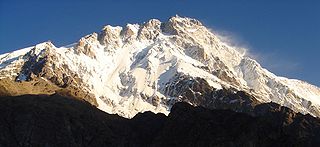
Günther Messner was an Italian mountaineer from South Tyrol and the younger brother of Reinhold Messner. Günther climbed some of the most difficult routes in the Alps during the 1960s, and joined the Nanga Parbat-Expedition in 1970 just before the beginning of the expedition due to an opening within the team.

Adam Radosław Bielecki is a Polish alpine and high-altitude climber, known for the first winter ascents of the eight-thousanders: Gasherbrum I and Broad Peak. In his book Spod zamarzniętych powiek, written with co-author Dominik Szczepański, Bielecki tells the story of his climbings, memories from Himalayan expeditions, and the effort the highest mountains demand.

The 2013 Nanga Parbat massacre was a terrorist attack that took place on the night of 22 June 2013 in Gilgit–Baltistan, Pakistan. About 16 terrorists, reportedly dressed in Gilgit−Baltistan Scouts uniforms, stormed a high-altitude mountaineering base camp and killed 11 people; 10 climbers and one local tourist guide. The climbers were from various countries, including Ukraine, China, Slovakia, Lithuania and Nepal. A Chinese citizen managed to escape the assailants, and a member of the group from Latvia happened to be outside the camp during the attack. The attack took place at a base camp on Nanga Parbat, the ninth-highest mountain on Earth. The mountain is popular among trekkers and mountaineers, and is typically toured from June to August because of the ideal weather conditions during these months.
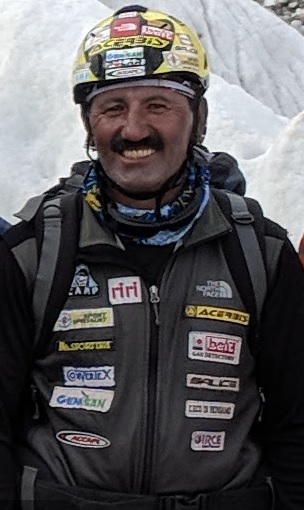
Qudrat Ali is a Pakistani mountaineer. He is a co-founder of Shimshal Mountaineering School, where he gives technical training in mountain climbing. He is also a distinguished member of the Alpine Club.
Tunç Fındık is a Turkish professional climber, mountaineer, mountain guide, author, and motivational speaker.
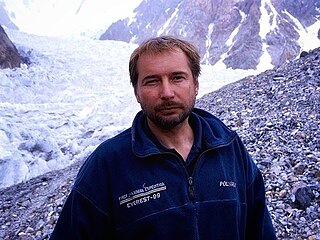
Igor Svergun was a Soviet and Ukrainian climber, who climbed many of the highest mountains in the world.
Karl Maria Herrligkoffer was a German medical doctor, who from 1953 and 1986, organized and directed numerous German and Austrian mountaineering expeditions including 13 expeditions to five of the world's highest peaks in the Himalayas and the Karakoram. There were some notable successes on these expeditions including the first ascent of Nanga Parbat (8126m), and also the second and third ascent of that mountain, the successful ascent of Everest (8849m) by 15 people from one expedition, the first ascent of the South Ridge of K2 (8611m), the first attempt on Broad Peak (8051m), and the first ascent of about 35 peaks during two expeditions to east Greenland.
Richard Frank "Rick" Allen was a Scottish mountaineer. Allen summitted six eight-thousanders and was the first British climber atop some of Tajikistan's biggest mountains. He had over 40 years experience climbing in the Himalayas at the time of his death.
References
- ↑ Miller, Delaney (March 21, 2023). "Remembering Oleksandr Zakolodny, 35".
- ↑ Miller, Delaney (March 21, 2023). "Remembering Hryhoriy Grigoriev, 35".
- ↑ "ARTICLE: Alexandr Zakolodniy - A Climbing Hero of Ukraine". www.ukclimbing.com. April 26, 2023.
- ↑ "Gli alpinisti ucraini Grigory Grigoryev e Alexander Zakolodny perdono la vita in guerra". PlanetMountain.com.
- ↑ "Президіум Федерації альпінізму і скелелазіння України від 23.02.2020".
- ↑ "Скеледром Спортивного комплексу "Вертикаль" | Альпклуб". alpclub.com.ua.
- ↑ "Олександр Заколодний | Альпклуб". alpclub.com.ua.
- ↑ "Four or more challenges on Makalu / All news / News / Аll projects of 7 Summits Club". 7summitsclub.com.
- ↑ "Некоторые материалы по нашему маршруту по Ю-З стене Макалу (обновлено — для свободного распространения)". July 4, 2010.
- ↑ "Nanga Parbat attack: Taliban say new faction killed climbers". BBC News. June 24, 2013.
- ↑ "Svergun Igor the top climber of Ukraine was among killed climbers and tourists in Pakistan". June 23, 2013.